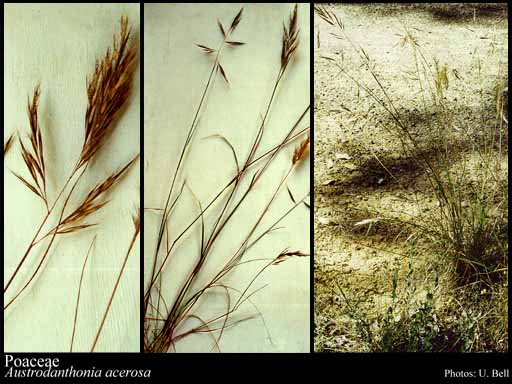- Reference
- Bull.Torrey Bot.Club 22:7 (1895)
- Name Status
- Current

Scientific Description
Common name. Grass Family.
Habit and leaf form. Herbs, or shrubs, or ‘arborescent’, or lianas, or herbaceous climbers; evergreen, or deciduous. ‘Normal’ plants (usually), or switch-plants (occasionally, e.g. Spartochloa, Xerochloa). Leaves well developed, or much reduced (rarely). Annual, or biennial, or perennial; plants with a basal concentration of leaves, or with neither basal nor terminal concentrations of leaves. Young stems cylindrical (usually), or oval in section; breaking easily at the nodes, or not breaking easily at the nodes (in bamboos). Stem internodes solid, or hollow (commonly). To (0.03–)0.1–30(–40) m high; when perennial, rhizomatous, or tuberous (rarely). Self supporting, or climbing (or decumbent); the climbers stem twiners, or root climbers, or scrambling. Hydrophytic to xerophytic; when hydrophytic, rooted. Leaves of hydrophytes submerged and emergent, or submerged, emergent, and floating. Not heterophyllous (usually), or heterophyllous (occasionally). Leaves minute to large; alternate; nearly always initially distichous (very rarely spiral — Micraira, the Orcuttieae); ‘herbaceous’ (usually), or leathery, or membranous (rarely); sessile, or petiolate; sheathing. Leaf sheaths tubular; with free margins, or with joined margins. Leaves not gland-dotted; without marked odour (usually), or aromatic (occasionally); simple. Leaf blades entire; flat, or folded, or rolled, or solid (rarely); setaceous, or acicular, or linear to obovate; parallel-veined (usually), or pinnately veined to palmately veined (rarely); without cross-venules, or cross-venulate. Leaves nearly always ligulate (though the ligule is often reduced to a fringe of hairs or even to papillae, sometimes lacking on upper leaves, as in Echinochloa, and totally absent from the lilylike leaves of Neostapfia and the Orcuttieae). Leaf blade margins nearly always entire; flat, or revolute, or involute. Prophylls 1. Leaves with a persistent basal meristem, and basipetal development. Vernation conduplicate, or involute, or revolute, or convolute, or plicate (rarely). Vegetative anatomy. Plants with silica bodies. Leaf anatomy. Leaf blade epidermis nearly always conspicuously differentiated into ‘long’ and ‘short’ cells. Guard-cells ‘grass type’ (inevitably with an exception — Neostapfia). Stem anatomy. Secondary thickening absent.
Reproductive type, pollination. Fertile flowers hermaphrodite, or functionally male and functionally female, or functionally male, or functionally female, or hermaphrodite and functionally male, or hermaphrodite and functionally female, or hermaphrodite, functionally male, and functionally female. Unisexual flowers present, or absent. Plants hermaphrodite, or monoecious, or andromonoecious, or gynomonoecious, or dioecious, or androdioecious, or gynodioecious, or polygamomonoecious. Plants viviparous (occasionally), or not viviparous. Floral nectaries absent (nectaries absent). Almost exclusively anemophilous (with possible exceptions in South American forest-floor Olyreae).
Inflorescence and flower features. Flowers aggregated in ‘inflorescences’ (these consisting of at least one ‘spikelet’); in ‘spikelets’. The terminal inflorescence unit (the spikelet) cymose (e.g. Panicoideae), or racemose (e.g. Pooideae). Inflorescences terminal, or axillary; with 1–50 florets and vestiges grouped into characteristic ‘spikelets’ in association with specialised bracts termed ‘glumes’, ‘lemmas’ and ‘paleas’, the spikelets variously gathered into simple or compound panicles, racemes, spikes, heads or fascicles; with involucral bracts, or without involucral bracts; spatheate, or espatheate. Flowers bracteate (in that the spikelets normally exhibit glumes and lemmas, and the other inflorescence branches are sometimes spatheate or spatheolate); bracteolate (if the palea, when present, is interpreted as a bracteole), or ebracteolate; minute to small. Perigone tube absent. Hypogynous disk absent. Perianth vestigial (if the lodicules are interpreted as perianth), or absent (the lodicules being sometimes absent); 0, or (1–)2–3(–6); 1 -whorled; (lodicules) free to joined. Fertile stamens present, or absent (when female). Androecium (1–)2–3, or 4 (rarely), or 6, or 6–120 (Ochlandra). Androecial members free of the perianth, or adnate; usually free of one another, or coherent (occasionally, the filaments are joined to one another or to the lodicules). Androecium exclusively of fertile stamens. Stamens (1–)2–3, or 4, or 6–120; filantherous. Anthers basifixed (sagittate); non-versatile; dehiscing via pores, or dehiscing via short slits, or dehiscing via longitudinal slits; extrorse, or introrse, or latrorse; tetrasporangiate. Pollen shed as single grains. Fertile gynoecium present, or absent (when male or sterile). Gynoecium theoretically 2(–3) carpelled. The pistil 1 celled. Gynoecium syncarpous; synovarious to eu-syncarpous; superior. Ovary unilocular; 1 locular. Styles 1, or 2(–3); free to partially joined; attenuate from the ovary, or from a depression at the top of the ovary; apical, or lateral. Stigmas (1–)2–3; dry type; papillate, or non-papillate; Group I type (usually), or Group II type (rarely, IIB). Placentation basal to parietal (stachysporous, the ovule fused to the adaxial wall). Ovules in the single cavity 1; sessile (usually adnate); non-arillate; anatropous, or campylotropous, or hemianatropous.
Fruit and seed features. Fruit non-fleshy (usually), or fleshy (occasionally); indehiscent; a caryopsis (usually), or achene-like (not infrequently), or a nut, or a berry. Dispersal unit the fruit, or the inflorescence. Seeds nearly always endospermic. Endosperm not ruminate (very rarely ruminate); not oily. Seeds with starch. Embryo well differentiated. Cotyledons (usually identified with the scutellum) 1. Embryo achlorophyllous (9/13); straight, or bent. Seedling. Hypocotyl internode absent. Mesocotyl present, or absent. Seedling collar conspicuous (in the form of an ‘epiblast’), or not conspicuous. Cotyledon hyperphyll compact; non-assimilatory. Coleoptile present. Seedling cataphylls present (in some bambusoids), or absent. First leaf dorsiventral. Primary root ephemeral.
Physiology, biochemistry. Plants accumulating free oxalates (e.g. Setaria anceps), or not accumulating free oxalates. Photosynthetic pathway: C3, or C4, or C3 and C4, or C3-C4 intermediate.
Geography, cytology, number of species. Holarctic, Paleotropical, Neotropical, Cape, Australian, and Antarctic. World distribution: cosmopolitan. About 12000 species.
Economic uses, etc. Economically the most important of families — cereals, sugarcane, fodder and pasture, alcohol, thatching, matting, bamboo construction work, etc.